| 
MARKET SUMMARY
The Canadian equity market had strong investment returns this
year. The Toronto Stock Exchange S&P/TSX Index, which measures
the performance of Canada's top companies, reported an increase
of 13.9% compared to an increase of 37.7% the previous year. Higher
personal consumption, low interest rates, surging employment,
strong exports, and rising disposable income contributed to the
buoyant economy. The housing market in particular, continued to
be robust.
Oil prices increased to record levels during the year before settling
down by year-end. At the beginning of the year, West Texas Intermediate
(WTI) opened the year at $35.78 US per barrel and closed at $55.41
US per barrel by year-end. The energy sector led all other sectors
in the S&P/TSX Index returning 43.6% over one year.
The US dollar continued its decline
against the Canadian dollar. By March 31, 2005, $1 US purchased
$1.21 Canadian compared to $1.31 Canadian at the beginning of
the year. As a result, the value of the Fund's US equity investments
declined when translated into Canadian dollars resulting in lower
investment returns.
At March 31, 2005, the Bank of Canada
overnight rate was 2.5%, while the US Federal Reserve Fund rate
ended the year at 2.75%.
Equity markets in the U.S. grew at
a more modest pace. While capital investment was strong, other
indicators, such as weaker than expected employment numbers and
lower than expected consumer spending, resulted in modest growth.
In addition, record oil prices during the year inhibited growth
in the U.S. economy. The S&P 1500 Index, which tracks the
performance of the top 1500 American companies increased by 7.2%
over the year in U.S. dollars and negative 1.0% in Canadian dollars.
Currency movements had a negative impact, pulling the U.S. returns
down when translated into Canadian dollars.
Non-North American markets performed
well. The Morgan Stanley Capital International Index for Europe,
Australasia, and the Far East, MSCI EAFE Index, measures the performance
of approximately 1,000 companies on 21 stock exchanges around
the world. The index increased by 9.4% during the year in local
currency and 6.2% in Canadian dollars. Growth in demand from China
continued to be strong, keeping commodity prices firm. The Japanese
economy showed growth due in part from exports to China. Activity
in Europe has improved somewhat, while growth in the Euro-Zone
remained modest. France and Germany posted weak numbers in employment
and for domestic and foreign demand.

FUND VALUE AND
TRANSFERS TO THE GENERAL REVENUE FUND
At March 31, 2005, the fair value of the Heritage Fund totalled
$12.2 billion. Since 1976 total transfers to the GRF have increased
to approximately $27.6 billion.

CHANGE IN
FAIR VALUE OF FUND
The Heritage Fund accounts for its investments and investment
income on a cost basis of accounting, which excludes unrealized
gains and losses. Investments and investment income on a fair
value basis includes unrealized gains and losses. The investment
income on a fair value basis for fiscal year 2004-05 is $918 million
(2003-04: $2,454 million).

INVESTMENT INCOME
The Fund recorded net income of $1,092 million during fiscal year
2004-05 compared to $1,133 million in the previous year. Of the
total income earned during the year, $424 million came from interest,
dividends, real estate income and security lending income, net
of administrative fees and $668 million came from net realized
gains from sale of securities and gains and losses from derivative
transactions.

TRANSFERS
TO THE GENERAL REVENUE FUND
Net investment income earned by the Heritage Fund is not reinvested.
Instead, all of the net income is transferred to the Province's
General Revenue Fund (GRF). Unrealized gains and losses are not
included in amounts transferred to the GRF.
The Fund's net income for the year
ended March 31, 2005, amounted to $1,092 million of which $1,030
million was transferred to the GRF and $62 million remains payable
to GRF.
The Government of Alberta financial
statements are prepared on a consolidated basis, which eliminates
the income the Heritage Fund earns from Alberta provincial corporation
securities totaling $16 million for the year ending March 31,
2005. On a consolidated basis the Heritage Fund net income was
$1,076 million.
INVESTMENT
VALUATION
Investments and investment income are recorded on the financial
statements of the Heritage Fund at cost in accordance with government
accounting policies. The fair value of the Fund and its investments
are provided for information purposes. Management uses fair value
to assess the investment performance of the fund against market-based
benchmarks.
The Fund's policy is to write down
the cost of those securities where the decline in value below
cost is not considered temporary. On a quarterly basis, management
reviews the Fund's investment portfolio to identify those securities
where the fair value has declined significantly below cost. The
Fund's net income for fiscal 2004-05 includes writedowns, primarily
to public equities, totalling $34.4 million (2003-04 $2.6 million).

INVESTMENTS
Asset
Mix
The investment strategy is to invest in a diversified portfolio
to optimize long-term returns at an acceptable level of risk.
The policy asset allocation is reported in the Fund's 2004-07
business plan as follows:
Based on the Heritage Fund 2004-07
business plan, the long term policy asset mix for fixed income
securities decreases from 35.0% to 32.5%. The long-term policy
mix for public equity investments remains the same at 45.0%. The
reduction in Canadian fixed income securities is offset by an
increase in absolute return strategy investments. Absolute return
strategy investments increase from 5.0% to 7.5% of total portfolio
investments. The target for real estate investments is expected
to remain unchanged at 10.0% of total portfolio investments.
The actual investment mix for fixed
income securities decreased slightly to 32.7% from 33.2% at the
beginning of the year. Public equity investments decreased to
50.8% from 54.1%. Real estate investments increased to 9.7% from
7.6% of the Fund's total investment portfolio. Absolute return
strategies increased to 5.0% from 4.0% of the Fund's investment
portfolio. Private equity and income investments increased to
1.8% from 1.1%.
New Investment
Products
Over the year, a number of new investment products have been introduced
in order to further diversify the Heritage Fund's investment portfolio
(see Note 3 to the financial statements). In particular the Fund
reduced its investment in U.S. large cap equities and purchased
U.S. portable alpha investments, which blend absolute return strategies
within a portfolio of derivatives such as equity swaps and futures.
In the non-North American sector, the Fund added investments in
emerging markets. The Fund also redeemed its entire investment
in Canadian small cap equities and increased its investment in
Canadian and foreign private equities and real estate. During
the year, the Fund restructured its actively managed Canadian
large cap equity portfolio using enhanced index and multi-cap
products. The Canadian enhanced index product generates a consistent
level of return above the S&P/TSX Index with relatively low
risk. The Canadian multi-cap product blends both internally managed
structured investments replicating the S&P/TSX 60 Index with
externally managed equity investments in small and mid capitalized
companies. The Fund also implemented an investment overlay strategy,
which uses exchange-traded futures to obtain exposure to a particular
asset class on a largely unfunded basis.

HERITAGE
FUND RATE OF RETURN
The Heritage Fund posted an overall rate of return of 7.7% this
year, 130 basis points better than the Fund's benchmark return
of 6.4%. The Fund earned positive returns from all asset classes.
The performance of
the Heritage Fund is measured over the long term. Over the past
five-year period, the fund generated a nominal annualized return
of 4.1%. The Heritage Fund is expected to generate a real rate
of return of 4.5% at an acceptable level of risk over a moving
five-year period. Over a five-year period, the annualized inflation
rate was 2.4%. Therefore, the Fund was expected to generate
a nominal annualized rate of return of 6.9%. Over the past five
years, returns from world equity markets have under-performed
historical long-term average rates of return.

The performance of the
Heritage Fund investments is measured against various market-based
indices. Value added by investment management is accomplished
through asset mix decisions and security selection. The following
sections describe the performance of the Fund's major asset classes
in relation to their benchmarks.

FIXED INCOME INVESTMENTS
The Scotia Capital (SC) Universe Bond Index measures the performance
of marketable Canadian bonds with terms to maturity of more than
one year. Over the past year, the SC Universe Bond Index increased
by 5.0% while the short term SC 91-Day T-Bill Index increased
by 2.2%.

The Fund's actual rate
of return over the year from long-term Canadian fixed income securities
was 5.5%, 50 basis points better than the benchmark SC Universe
Bond Index. Over five years, the return from long-term fixed income
securities was 8.4% or 70 basis points better than the benchmark
of 7.7%. The Fund's return from short-term securities was 2.3%
and 3.5% over one year and five years respectively. The Heritage
Fund's fixed income portfolio is internally managed through various
pools and through direct holdings.
At March 31, 2005, investments in
deposits, bonds, notes, short-term paper, provincial corporation
debentures and loans totalled 32.7% of total portfolio investments
or $4.0 billion down from 33.2% or $4.2 billion at March 31, 2004.
The Fund's Canadian fixed-income portfolio is comprised of diversified
holdings in corporate, federal, provincial and municipal bonds,
notes and short-term paper.
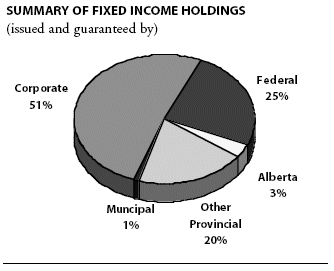
CANADIAN
EQUITY INVESTMENTS
The Canadian stock market finished the year on a positive note.
The Toronto Stock Exchange S&P/TSX Index, which measures the
performance of Canada's top companies, reported a return of 13.9%
for the year ending March 31, 2005. During the year, the energy
and telecommunications sectors led all sectors with returns of
43.6% and 23.6% respectively. The healthcare sector finished the
year with the lowest return of negative 25.3%.
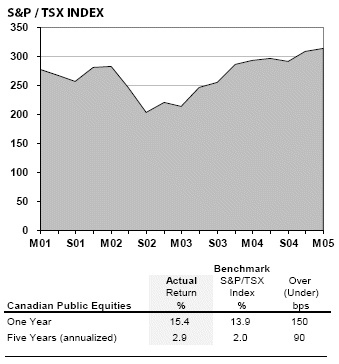
The Heritage Fund's Canadian equity portfolio is held in various
investment pools, which are managed by internal and external managers.
Over the year the Fund's actual return from Canadian equities
rose by 15.4%, 150 basis points better than the benchmark S&P/TSX
Composite Index of 13.9%. Over five years, the Fund's return from
Canadian equities was 2.9% compared to the benchmark return of
2.0%.
At March 31, 2005, investments in
Canadian public equities totalled 18.5% or $2.3 billion of the
Heritage Fund investment portfolio compared to 22.1% or $2.8 billion
one year earlier.
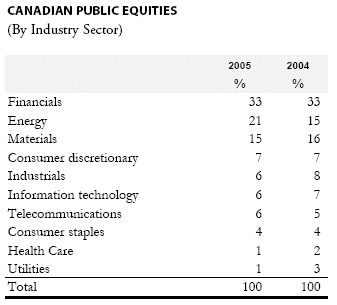
UNITED
STATES EQUITY INVESTMENTS
The U.S. equity market closed out the year posting a positive
return in US dollars. The Standard & Poor's 1500 Index, S&P
1500, which measures the performance of the top 1500 American
companies, rose by 7.2% in US dollars and negative 1.0% in Canadian
dollars.

The Fund's actual rate of return
over the year from US equities was negative 1.6% in Canadian dollars
or 60 basis points less than the S&P 1500 Index. Over five
years, the Fund's US equity portfolio returned a negative 6.3%,
20 basis points better than the benchmark.
At March 31, 2005, investments in
US equities totalled 16.2% or $2.0 billion of the Heritage Fund
investment portfolio compared to 15.6% or $2.0 billion at March
31, 2004.

NON-NORTH
AMERICAN EQUITY INVESTMENTS
The non-North American equity market recorded an overall positive
return this year. The Morgan Stanley Capital International Index
for Europe, Australasia, and the Far East, MSCI EAFE Index, measures
the performance of approximately 1000 companies on 21 stock exchanges
around the world. The index increased by 6.2% over the year, in
Canadian dollars.

The Fund's actual return from non-North
American equities was 7.6%, 140 basis points better than the benchmark
MSCI EAFE Index. Over five years the Fund's non-North American
equity portfolio returned a negative 4.8%, 10 basis points less
than the benchmark MSCI EAFE Index.
At March 31, 2005, investments in
non-North American equities totalled 16.1% or $2.0 billion of
the Heritage Fund investment portfolio compared to 16.4% or $2.1
billion at March 31, 2004.
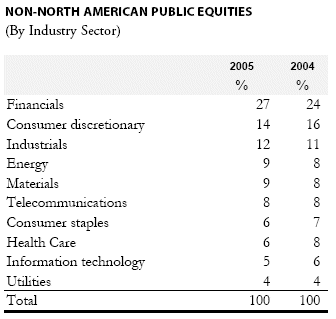
The Fund's Non-North
American equity portfolio is invested through out the world.
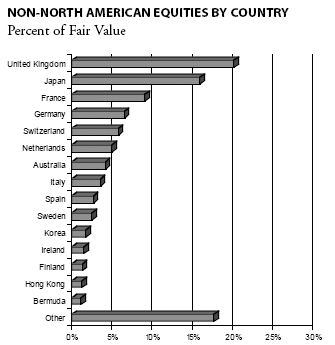
REAL
ESTATE INVESTMENTS
The Fund's real estate investments are held in the internally
managed Private Real Estate Pool and in the newly created Foreign
Private Real Estate Pool. Real estate investments earned 17.0%
over the year and 10.2% over five years. The outperformance over
one year was due to strong returns from the portfolio’s
retail assets.

Nearly half of the real
estate portfolio is invested in retail, half in office and a small
portion in industrial and residential. Approximately 66% of the
real estate holdings are located in Ontario, 21% in Alberta, 11%
in Quebec and 2% in British Columbia.
At March 31, 2005, investments in
real estate totalled 9.7% or $1.2 billion of the Heritage Fund
investment portfolio compared to 7.6% or $950 million at March
31, 2005.
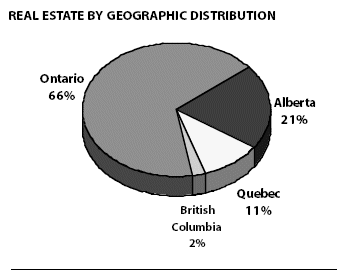
ABSOLUTE
RETURN STRATEGIES
Absolute return strategy investments encompass a wide variety
of investments with the objective of realizing positive returns
regardless of the overall market direction. A common feature of
many of these strategies is buying undervalued securities and
selling short overvalued securities. Over the year absolute return
strategies generated a positive return of 5.5%, 260 basis points
less than the benchmark Consumer Price Index (CPI) plus 6.0%.

At March 31, 2005, investments
in absolute return strategies totalled 5.0% or $611 million of
total Fund investments compared to 4.0% or $507 million at March
31, 2004.
PRIVATE
EQUITY AND INCOME INVESTMENTS
At March 31, 2005, the private equity and private income portfolio
comprised a small portion of the Fund's overall investment portfolio
at 1.8% or $214 million compared to 1.1% or $136 million at March
31, 2004.
During the year, the private equity
and private income portfolios returned 5.2% and 5.3% respectively
compared to their benchmark returns of 10.1% and 8.1% respectively.
Investments in the early stages of development are expected to
have lower returns due to higher initial management fees and start-up
costs
.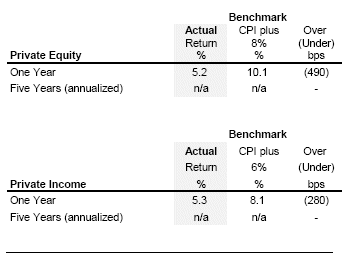

Administrative
Expenses
Administrative expenses
include expenses incurred to manage the Fund’s investment
portfolio. Fees charged by external managers are deducted directly
from the income of externally managed investment pools. Internal
investment management costs are deducted from the internally
managed pooled funds and also directly from the Fund. External
investment management fees are based on a percentage of net
assets under management at fair value. Internal investment management
expenses are based on a cost recovery basis.
The Fund's total administrative
expenses for the year ended March 31, 2005, including amounts
deducted from the investment income of the pooled funds, amounted
to $20,708,000 or 0.169% of the Funds net assets at fair value
compared to $17,929,000 or 0.145% the previous year.

The Fund's direct investment
expenses and allocation from internally managed investment pools
increased by $325,000 compared to last year. The Fund's allocation
of expenses from externally managed investment pools increased
by $2,454,000 compared to last year. Increases in external management
fees and assets under management for non-North American equities
contributed to the increase in externally managed fees.
Approximately 80% of total administrative
expenses relate to investment management and 20% relate to administration.

|










